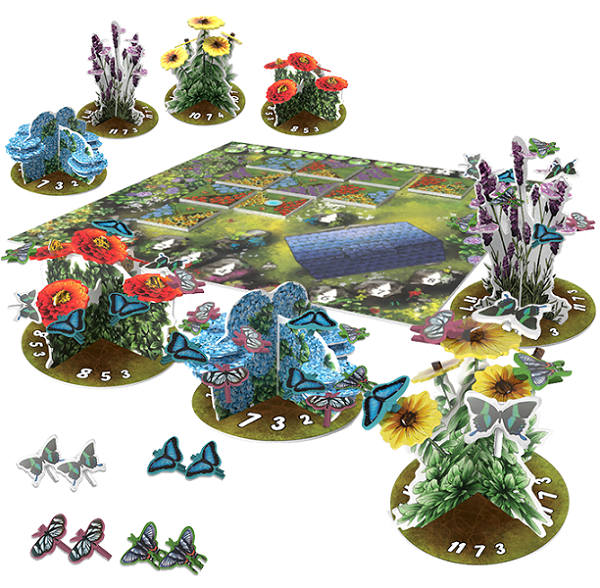Grow Your Own Garden to Attract Beautiful Butterflies in Papillon

It's a beautiful day to smell the roses, to watch the butterflies, and grow a large and colorful garden.
Papillon is a tile laying game with some truly lovely and eye-catching components, but does the gameplay measure up to the aesthetics?
Gameplay
Papillon is played over eight rounds with each round having four phases. During the preparation phase, ten tiles are drawn and placed on the board. They are placed so that there are four tiles in one column/row, three in the next, two in the next, and one in the last column/row. A gnome token is placed at the intersection of two of these rows and caterpillars are played on some tiles as well.
Next is the bidding phase. The player who drafted first in the previous round begins the bidding; he chooses how many caterpillars he will bid and places his pawn on the corresponding spot on the bidding track. The next player then bids in a similar fashion, and so on until each player has had a chance to bid. You may never bid the same number of caterpillars that another player has already bid this round, with the exception of zero. If you bid zero caterpillars, you place your pawn on the right most zero spot on the bidding tracker. If another player after you bids zero, your pawn will be moved back one space. After bidding is completed, players on the zero spots will collect caterpillars, earning more based on how far back their spot is. Everyone else pays the number of caterpillars that they bid.
Next is the drafting phase. Going in order, from right to left on the bid track, each player claims one row or column of tiles. If you claim one that only has a single tile on it, you also draw one at random from the bag. The first player to claim either the row or column that points to the gnome claims the gnome token, flips it over, and collects the number of caterpillars indicated on the token. If you draft tiles with caterpillars, you earn those caterpillars as well.
After the drafting phase is the gardening phase, during which all players, simultaneously, add their tiles to their own gardens. Each tile shows four sections and there are five possible sections: red, blue, yellow, or purple flowers, and lawn. When adding a tile to your garden, you must place it adjacent to another tile and any connecting sides must match. A segment of your garden is considered closed when it is made up of two or more matching sections and there are no sides to which an additional section could be added. When you close a segment of flowers, you must place one of your butterflies on it, either from your supply or removing it from one of the standing flowers.
There are eight flower stand-ups, two for each of the flower colors in the game. The fourth phase of each round is the butterfly phase. Starting with the player who drafted tiles last, you place a butterfly for each completed section onto the matching flower (if you did not place a butterfly in your garden this round, you skip this phase). If there were three or more matching sections in that segment, you claim that flower's bonus token if it has not already been claimed (each bonus token can only be claimed once per game) and you get to clip a second butterfly from your supply onto the flower.
After eight rounds, players score points for having the first, second, or third most butterflies on each flower, one point for each caterpillar they still have, one point for each butterfly depicted on closed lawn sections, and two points for each section in their two largest closed segments. The player with the most points wins.

Review
Papillon is a very eye-catching game with a fantastic table presence. It is bright and colorful (befitting of the theme) and the 3D flowers and butterflies are lovely, engaging, and do a great job of setting the game apart from other tile placement games.
The game play is intuitive and streamlined, both in rules and scoring. There is a nice, smooth flow to the game with all scoring saved until the end and turns are quite fast. Since all tile laying is simultaneous, there is little waiting around — though it can get difficult to keep track of which tiles you played during a particular round as your garden grows. The bidding and drafting, together with the scoring of the flowers, helps to increase the player interaction so that so you're never in your own little world, solely focused on your own tiles.
Clipping the butterflies onto the flowers is a really fun, tactile element of the game, However, setup is rather long because of the flower assembly. While everything looks amazing, we did run into some issues with the components. The stands are difficult to squeeze into the scoring rings and the butterflies are quite delicate. Some came out of the box already separated from their clothespin-style clips and had to be glued right away, while others broke apart while playing. We were also missing one butterfly, but fortunately a few extra pieces are included in the box (which need to be glued before you can use them). It would be great to have custom molded butterfly clips that don't require any glue.
Overall, if you enjoy tile laying games, and don’t mind having to do the occasional component repair, Papillon brings something a little new to the table. We enjoyed the bidding and tile-laying mechanisms and found the gameplay to be quite smooth and intuitive.
Pros: Player interaction mixed with tile laying, attractive components, clipping the butterflies onto the flowers is a great mechanic
Cons: Some component quality issues
Disclosure: we received a complimentary review copy of this game.






